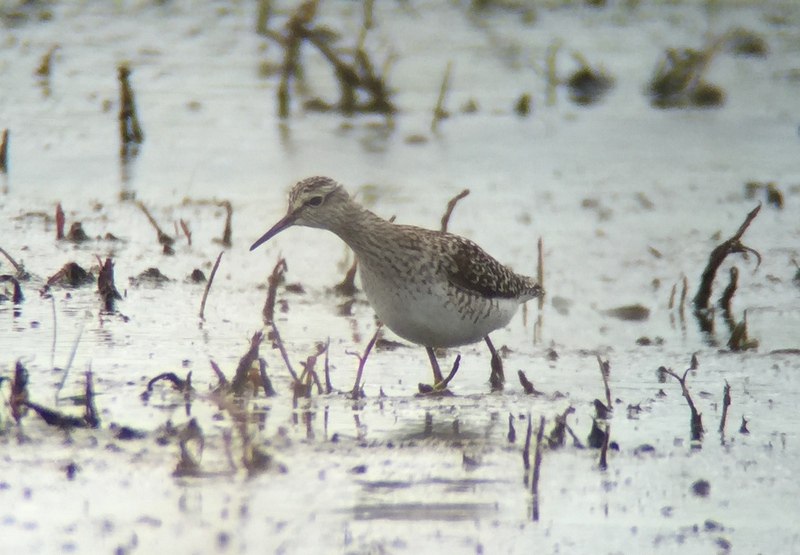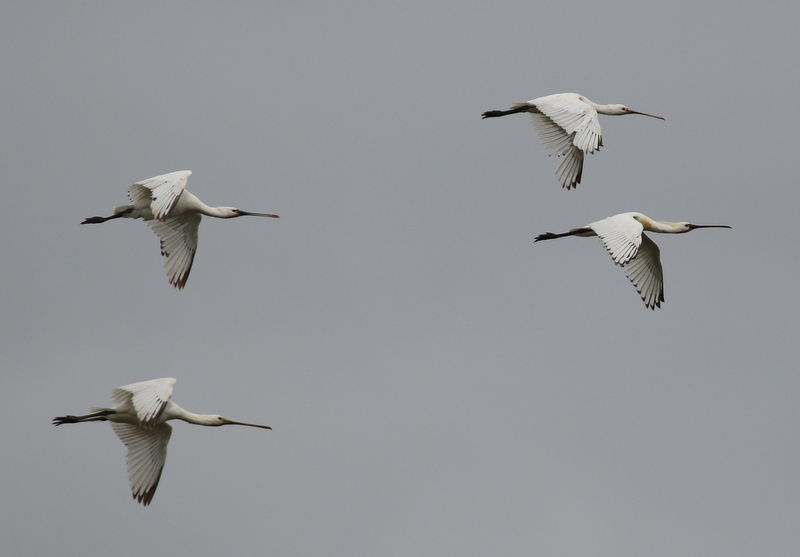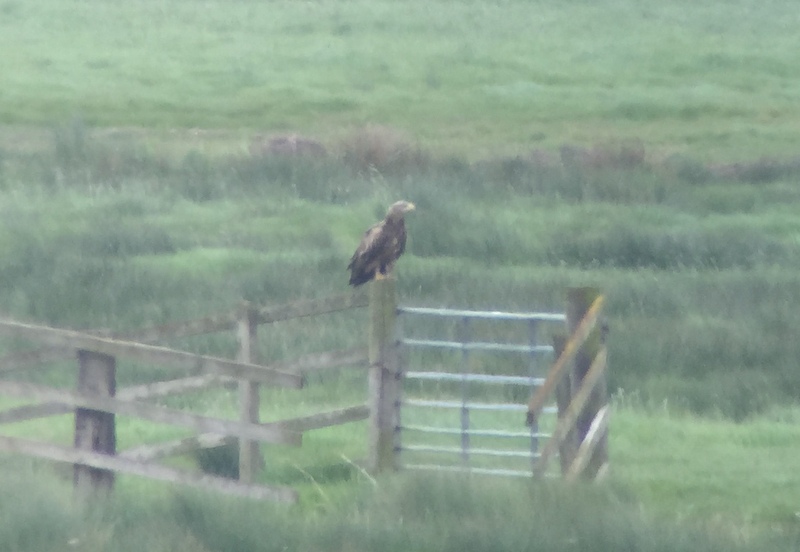A Private Tour today, down in the Norfolk Broads. The weather seemed promising early on, with some brightness first thing, but it clouded over. A cold north-easterly wind, gusting to 30mph plus all day, meant that it was hard going at times, but at least it stayed dry.
After a slightly later than expected departure, due to an alarm clock malfunction for one of the tour participants, we headed over to Potter Heigham. Hickling Broad was our first destination for the morning, or more precisely the Weavers’ Way footpath which runs along the south side and overlooks Rush Hill Scrape.
As we walked out across the fields, a male Yellowhammer sang from the hedge and a female flew across to join it. Making our way through the trees, we could hear Blackcap, Chiffchaff and all singing. From up on the bank, there were lots of Sedge Warblers songflighting up from the reedbed, and a couple of Reed Warblers singing too.
There has been a Savi’s Warbler here for the last couple of weeks, and we were hoping to see it again today. Unfortunately, when we got to the bushes from which it has been reeling, the wind was lashing through them. We waited a while, but there was no sign of it this morning. Over the Broad beyond, we could see lots of Common Swifts and a few House Martins. Both have been in short supply so far this spring, so it was nice to see both species in numbers today. There were several Common Terns hawking over the water too.
We wandered along to the hide overlooking Rush Hill Scrape to see if there was anything on there today. Apart from a lone Redshank, there were no other waders on here, until a pair of Avocet flew in. A single Wigeon was the highlight of the ducks. While we sat in the hide for a few minutes, to escape from the wind, we could just hear snatches of a Grasshopper Warbler reeling nearby.
Given the windy conditions, we decided to cut our losses and head round to Potter Heigham Marshes. It was well worth it. A quick stop overlooking the first pools revealed a very nice selection of birds to get us started. A Wood Sandpiper appeared from behind the reeds at the front, quickly followed by a second. Further back, we could see about fifteen Ringed Plovers, migrants waiting to continue their journey north, and several Ruff, including a male coming into breeding plumage.
 Wood Sandpiper – one of two on the first pool we looked at
Wood Sandpiper – one of two on the first pool we looked at
On the next pool along, a smart male Garganey swam out from the front and disappeared behind some reeds. There were also three Grey Plover on here, including one looking very smart in full summer plumage, with black face and belly and white spangled upperparts.
 Garganey – swam out from the front of one of the pools
Garganey – swam out from the front of one of the pools
The pools at the far end were rather deeper, with just a few ducks and geese. We climbed up onto the bank to make our way round to the river bank and the pools the other side. As we did so, we had a quick look at the grazing marshes beyond and spotted a single Common Crane feeding in the damp grass. We had a great look at it through the scope, looking through the reeds. They were herding cows in the field beyond, and all the activity seemed to unsettle it. The Crane took off and flew over the trees towards Hickling.
 Common Crane – feeding on the grazing marshes
Common Crane – feeding on the grazing marshes
There were loads of hirundines hawking over the reedbed this side, mostly House Martins but also a few Swallows. Down at the river, a pair of Great Crested Grebes were out on the water. We made our way along the bank, round past the various pools on that side. The first couple held a few ducks and geese, plus a couple of Little Egrets. A single Common Snipe on a grassy island was a nice bonus.
 Great Crested Grebe – a pair were on the river today
Great Crested Grebe – a pair were on the river today
There have been several Spoonbills here in recent days, and we were disappointed we had not managed to find them so far. As we approached the last pool, we still hadn’t seen them until we got past the reeds along its near edge. There they were! Four Spoonbills were sleeping in the lee of the reeds, out of the wind, quite close to the bank where we were walking. We stopped where we were but they were surprised by our sudden appearance and walked out into the pool before taking off.
 Spoonbills – we surprised them, hiding asleep in the lee of the reeds
Spoonbills – we surprised them, hiding asleep in the lee of the reeds
The four Spoonbills flew round for a couple of minutes, giving us a great view as they did so, before landing again on one of the other pools, further back from the river bank. Here they quickly settled down to feed.
 Spoonbills – flew round and landed back down on the pools to feed
Spoonbills – flew round and landed back down on the pools to feed
There were more waders on this last pool. Another 20 or so Ringed Plover were accompanied by around 10 Dunlin. Looking through them carefully, we managed to find two diminutive Little Stints, looking very smart in summer plumage, with rusty-tinged upperparts fringed with frosty edges.
A Greenshank flew in and landed out of view. While we were scanning for it, we found a Common Sandpiper creeping around on the far bank. From a little further along, we were able to see the Greenshank where it had landed. Along with a few Avocet, Lapwing and Redshank, that meant this site had provided us with a great haul of waders today, including some nice scarce spring migrants.
We made our way back to the car and drove round to Cantley next. The young (2cy) White-tailed Eagle which has been roaming Norfolk and Suffolk for the last couple of weeks had been refound at Buckenham yesterday afternoon. After spending the night in trees nearby, earlier this morning it had flown over to Cantley Marshes, which was where we were hoping we might catch up with it.
Apparently the White-tailed Eagle had just been sitting on a gatepost for about three hours, but when we arrived it had just had a fly round and landed again down in the grass. We could see it very distantly through the scope, from the car park, being mobbed by a couple of the local Lapwings. It was clearly enormous – it completely dwarfed a couple of Canada Geese nearby! It flew again and landed on a gatepost a bit nearer to us, where we could get a better look at it.
 White-tailed Eagle – perched on a gatepost out on the marshes
White-tailed Eagle – perched on a gatepost out on the marshes
When the White-tailed Eagle took off again, we watched as it flew low across the marshes, scattering everything as it went. It gained height and seemed to be headed for the trees back at Buckenham, before we lost sight of it.
 White-tailed Eagle – took off and flew towards Buckenham
White-tailed Eagle – took off and flew towards Buckenham
After a short drive round there, we had a quick look out on the marshes at Buckenham, There was no sign of the White-tailed Eagle here – it was not on any of the gates, nor obviously sat out on the grass, and none of the local birds seemed particularly agitated. We figured it must have gone back into the trees somewhere.
The Cattle Egret was reported again at Halvergate earlier, so we drove round there next, but we couldn’t find it. We ate a late lunch overlooking the grazing marshes and scanning for it amongst the hooves of the various herds of cattle. It had probably had the good sense to find somewhere more sheltered, out of the wind which was whistling across the grass. A sharp call alerted us to a single bright male Yellow Wagtail which was feeding around the feet of the cows the other side of the road.
After lunch, we drove over to Winterton. It was even windier out on the coast. We walked up through the dunes and out onto the beach to see the Little Terns. There were lots of people here, busy erecting the electric fence to protect the Little Tern colony for the breeding season. We could see hordes of Little Terns flying round over the fence workers.
We then continued north through the dunes. It was rather quiet here today, with no obvious migrants on show. A Green Woodpecker flew up from the ground ahead of us and disappeared off round behind us. A male Stonechat perched on the top of a dead bush calling. We also flushed several Linnets from the dunes along the way.
 Stonechat – one of the few birds perching up in the dunes in the wind
Stonechat – one of the few birds perching up in the dunes in the wind
A Grasshopper Warbler was reeling from the brambles by the concrete blocks. We made our way into the trees along the track, hoping to find some birds in the more sheltered conditions here. There had been a few Garden Warblers here in recent days, but we couldn’t hear any today. A single Blackcap was singing intermittently, but a couple of Chiffchaffs and Willow Warblers were more vocal.
We walked inland a short distance. A Brown Hare disappeared ahead of us down the track. Four Stock Doves were feeding in a ploughed field. But there was nothing else of note in the lee of the trees. We decided to make our way back to the car, and with a long drive back up to North Norfolk, we headed for home.
There was one final treat in store. As we were almost back to our starting point, we noticed a small shape perched on the end of the roof of an old barn. It was a Little Owl. As we pulled up alongside, it stopped to stare at us. A nice way to end the day.
















